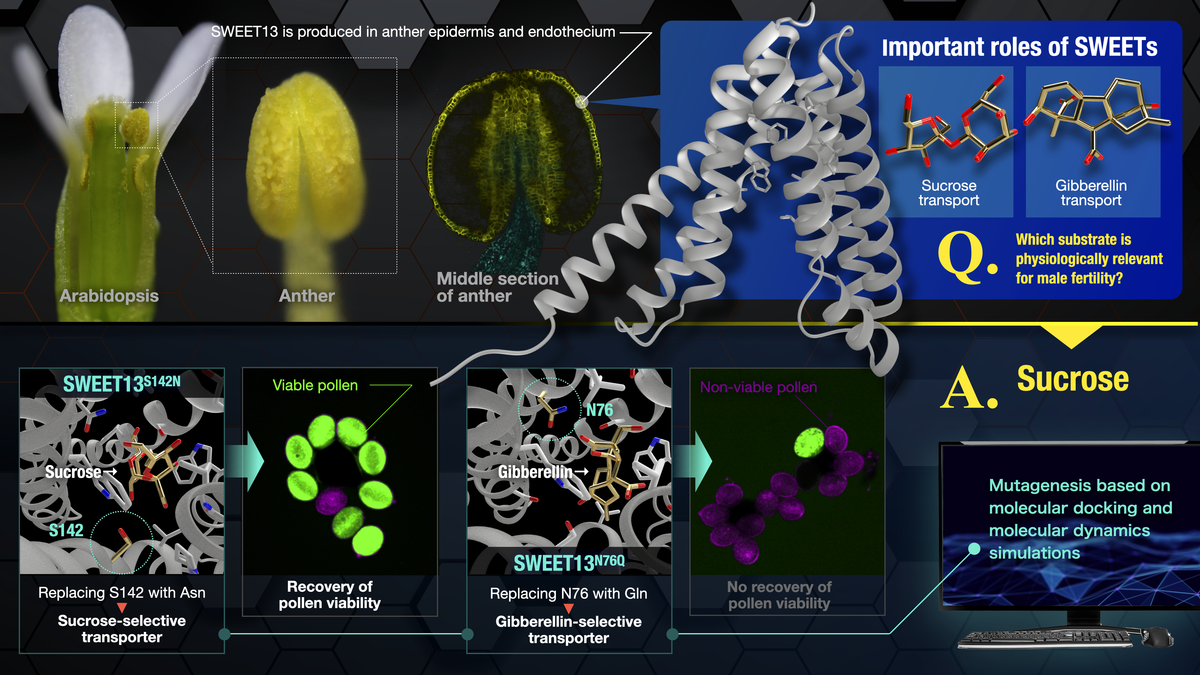SWEET13 transport of sucrose, but not gibberellin, restores male fertility in Arabidopsis sweet13;14

Researchers at Nagoya University, Japan, have discovered a mechanism for the selective transportation of sugar and hormones in plants. The results also clarify that sugar transportation is necessary for male fertility in plants, which means pollen production. The findings were published in Proceedings of the National Academy of Sciences.
Transporters are proteins that exist on cell membranes. Each transporter binds to a substrate and carries it across the cell membrane. Some transporters carry nutrition, while others carry molecules that, for example, help cells to communicate with each other. One class of transporters found in both plants and animals is Sugars Will Eventually Be Exported Transporter (SWEET). SWEET distributes sugar, such as sucrose, in plants. Once the SWEET binds to sucrose, it moves across the plant, distributing it so that the plant can get nutrition and grow. Here, sucrose, which is carried by the transporter, is called a substrate.
Importantly, SWEET has more than one substrate. For example, some types of SWEET in Arabidopsis plants also transport a hormone called gibberellin (GA), which controls plant growth and reproduction. These types of SWEET have the ability to transport sucrose and GA, but the physiological relevance of their respective transport activities is not understood. Both sucrose and GA are essential for plant growth and development, and each has a unique structure. "How SWEET can bind to both of these different structures, and how SWEET selects to transport sucrose or GA, were not clear", said Dr. Masayoshi Nakamura, a designated associate professor at the Institute of Transformative Bio-Molecules at Nagoya University.
Furthermore, when some types of SWEET are mutated in plants, the plant becomes male sterile, meaning that it cannot produce pollen. However, the reasons for this sterility were unclear. It may have been due to a lack of sucrose transport, a lack of GA transport, or both. To examine these questions, a research team led by Dr. Nakamura combined molecular dynamic simulation with classic genetic methodologies. In their experiments, they focused on a type of SWEET called SWEET13, which is known to transport both sucrose and GA, and is also necessary for male fertility.
To understand how sucrose and GA bind to SWEET and are transported by it, they first performed a technique called molecular dynamic simulation. This technique simulated a docking between SWEET13 and sucrose, and a docking between SWEET13 and GA, based on their structures. Using these computational simulations, the researchers predicted amino acids in SWEET13 that recognize sucrose and GA. Subsequently, using cell cultures, they confirmed whether these amino acids were necessary for the sucrose and GA transport activities of SWEET13. A particular site of SWEET13 with an amino acid called asparagine and serine was important for sucrose and GA transport activities, respectively.
Next, to clarify how the male sterility occurred, the researchers replaced one of the aforementioned amino acids, generating SWEET that transports only sucrose and SWEET that transports only GA. With SWEET that transports only sucrose but not GA, the plant produced pollens. However, with SWEET that transports only GA but not sucrose, the plant failed to produce pollens. These results mean that it is SWEET's transport of sucrose, not GA, that is necessary for pollen production.
"By combining molecular docking, molecular dynamics simulation and genetic methodologies, we successfully tested the selectivity of substrates [i.e., sucrose and GA] separately", said Dr. Nakamura. In addition, there are other transporters besides SWEET that carry multiple different substrates. "Our methodologies can examine other transporters and substrates, and that would advance research on transporters", he said. Understanding more about sugar and hormone transport in plants could lead to improved agricultural methods that are more efficient and sustainable than current practices.
Information
| Title | SWEET13 transport of sucrose, but not gibberellin, restores male fertility in Arabidopsis sweet13;14 |
|---|---|
| Author | Reika Isoda, Zoltan Palmai, Akira Yoshinari, Li-Qing Chen, Florence Tama, Wolf B.Frommer and Masayoshi Nakamura |
| Journal | Proceedings of the National Academy of Sciences |
| DOI | 1073/pnas.2207558119 |
| Date | 2022.10 |
